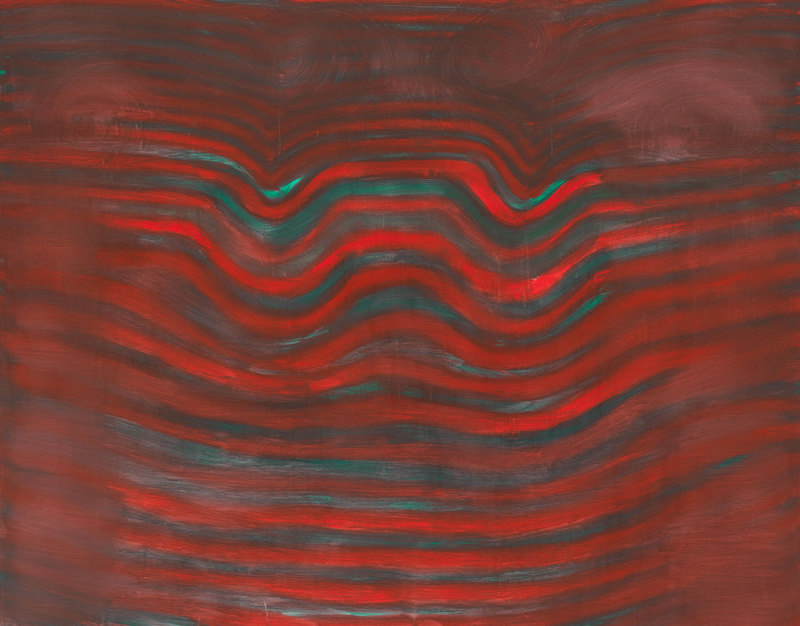
Contributed by Jonathan Stevenson / “Fast Forward: Painting from the 1980s,” the Whitney’s trenchant exhibition of American work, immediately recalls the Reagan era, when bluffness trumped irony and a turbocharged version of squareness — razor-sharp creases and collar bars, coke-fueled hostile takeovers, money in the service of comfort and status, strategic peremptoriness — shoved aside the counterculture. These trends ramified in art as the return of the figure via painters like David Salle and Eric Fischl, Julian Schnabel’s audacious neo-expressionism (he painted on broken dishes), and the exaltation of grown-up toys and commercial polish. Each phenomenon is well articulated in three rooms — thematically designated politics, appropriation, and abstraction — on the eighth floor of the museum.

One of the most evocative of the paintings selected for the appropriation room is Peter Cain’s Z (presumably alluding to the popular Chevy Camaro Z/28). The piece photo-realistically depicts the amputated front end of a sports car, tilting predatorily downward like an attacking shark (or, maybe more to the point, an aroused dick) yet incapable of propulsion. Pristinely presented and separated from its practical function, the concept conveys the notion of amassing things simply for the sake of image — here of a slick, aggressive machismo. Walter Robinson’s sly Baron Sinister and Kathe Burkhart’s Prick: From the Elizabeth Taylor Series (Suddenly Last Summer) register the facile if immaculate standardization of emotion, while Christopher Wool’s distressed untitled stenciling of the words RUN DOG RUN DOG RUN, stacked without spaces, more ominously suggests the illusoriness of mechanized perfection. And it was not, of course, only empty and mischievous reductionism that emerged from the 1980s. Despite the dismissively iterated “bonfire of the vanities” label, the period was devoid of neither irony nor conscience, tragedy nor wisdom.







AIDS was burgeoning and finds somber reference in Carlos Alfonzo’s haunting Told and Ross Bleckner’s elegiac Count No Count, and, more obliquely, in Terry Winters’ wafting molecular forms in Good Government, which resonates more broadly today. Some painters also apprehended the eighties as a time of revived political activism, stimulated particularly by the U.S. government’s support for brutal right-wing elements in Latin America. In the politics room, Leon Golub’s bravura White Squad I, with swaggering fatigue-clad figures casually brandishing weapons as they float over their fallen victims against a sanguine background, captures the idea with lurid grace. Fischl’s diptych A Visit To / A Visit From / The Island juxtaposes the tourist indulgence and native strife of Haiti. And Schnabel’s lacerating Hope — which thematically works now as well as it did then — reflects a mordant awareness that American opulence belies the existential mess and submerged guilt suggested by paintings like Jean-Michel Basquiat’s jangled LNAPRK and Keith Haring’s untitled piece alongside it.

Some of the work telegraphs the eclectic contemporary painting scene, lending weight to the show’s title. Kenny Scharf’s discomfitingly zany mural When the Worlds Collide must be an influence on Albert Oehlen and perhaps could, much more remotely, inform Nicole Eisenman’s work. Because it is so compact for a major museum exhibition and so tighty curated, the show leaves you wishing there had been more. The cluttered salon-style wall stifles Elizabeth Murray’s Druid, among other works, while singular but alas single Moira Dryer and Mary Heilmann paintings hint at segues to abstraction and feminism that might have been. The revived nuclear fears of the early 1980s also catch little if any light. By the same token, though, “Fast Forward” packs a very potent and coherent wallop, forcefully transmitting the possibility that the eighties, caricatured as a time of decadent sublimation (see Julia Wachtel’s drolly knowing Membership as well as Salle’s elegantly awkward Sextant in Dogtown), may be as culturally underrated as the seventies.
“Fast Forward: Painting from the 1980s,“The Whitney Museum, West Village, New York, NY. Through May 14, 2017.
















